It was a crisp winter’s evening in Ajabgarh, a village in Rajasthan’s Alwar district. Wrapped in our shawls, my husband and I were traversing in a well-kept, olive-green, open-top jeep. We drove past a hilltop fort, an ancient temple of Shri Raghunathji, crumbling walls and dilapidated houses; some with carved arches and ornate, painted doors. There was something eerily beautiful about these structures.
In a few minutes, we were surrounded by mustard and tobacco fields and frolicking village kids who took great pleasure in chasing our jeep. Soft rays of the sun seeping through the gau dhuli (cow dust) as cattle returned home after the day’s grazing added to the splendour of the Golden Hour. Coming across an idyllic spot overlooking a water body, our driver Balveerji promptly parked the jeep, unpacked a cane basket and pulled out a kettle and two little kulhads. “Sahib aur Sahiba, aap coffee aur cookies lenge na?” he asked with a sweet, demure smile which made it impossible for us to refuse the offer. Sipping the hot beverage, we lost ourselves in Balveerji’s engrossing folk tales from the region and gazed at the sky changing colours with the setting sun.
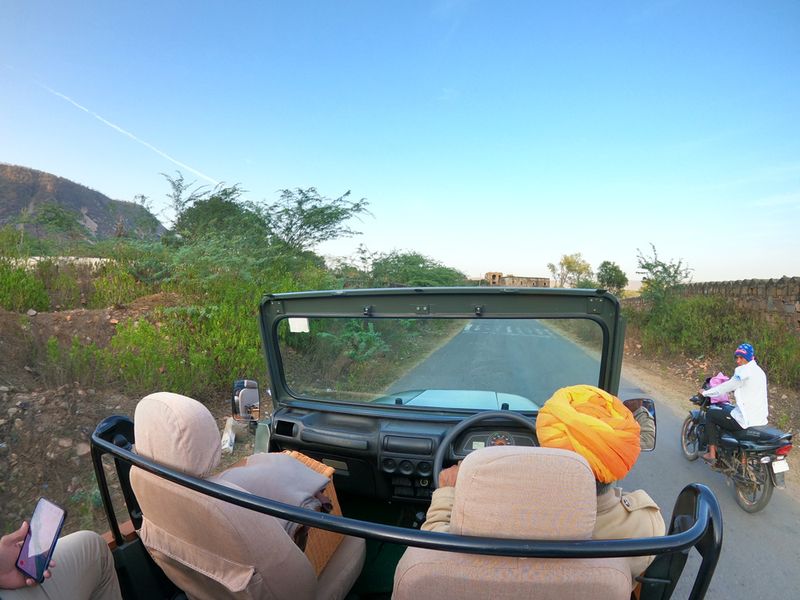
As we roamed through the hamlet’s narrow, unpaved alleys, we saw modest homes with roomy front and backyards; they exuded simplistic beauty and looked straight out of a movie set. For most city inhabitants leading frantic lives, the simple, easygoing farm life often remains a fantasy. Outside one of the houses, we saw a dhoti-clad septuagenarian squatting and smoking the traditional brass hookah. Being a sheesha devotee, my husband quickly hopped off the jeep for a smoke and a tête-à-tête. Our hearts were full from immersion in pastoral bliss and soulful interactions with the locals.

The base
Wondering what brings us to this undisturbed nook in the hinterlands of Rajasthan? Lured by the idea of exploring the state’s royalty, captivating history, and storied architecture minus the maddening crowds and pushy tour guides, we decided to bypass the flamboyant cities of Udaipur, Jaipur, Jodhpur and Jaisalmer to spend some time in the little-known Ajabgarh nestled in the low-rolling Aravalli Mountain range of India.

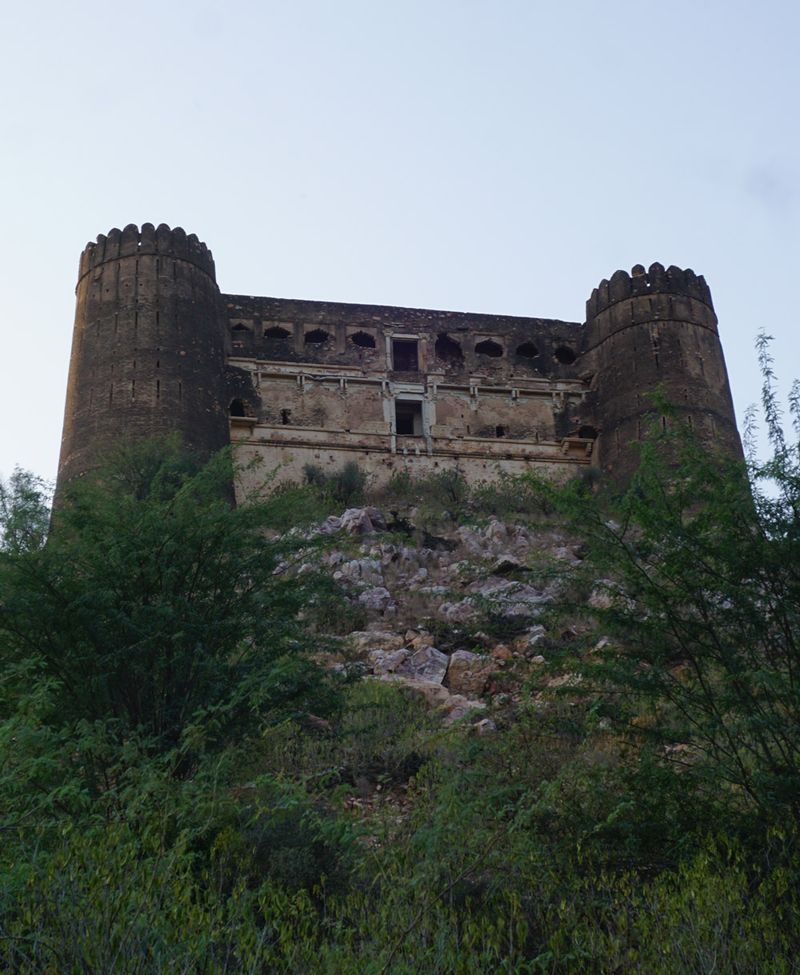
Located at a distance of around two hours from Jaipur and named after its founder Ajab Singh Rajawat - grandson of Madho Singh and grand-nephew of Raja Man Singh I, one of Emperor Akbar’s generals - Ajabgarh, until a century ago was home to country’s renowned sorcerers who practised black magic and witchcraft. According to locals, they cursed the village which led to all the residents abandoning their homes and farmlands and fleeing to bigger cities. While many are returning to the town, rituals to ward off evils are practised here even today.
The stay
We stayed at Amanbagh – an opulent boutique property located on the former camping grounds of the Maharaja of Alwar. Back then, the king and his revered guests, along with their entourages and elephants, paused here during the hunting expeditions. The old wall that surrounds the property is a remnant of that era.

The modern-day Mughal palace welcomed us with a sweet ceremony which involved tying a sacred, saffron-red thread around the wrist and chanting shlokas that soared in the high-ceiling lobby. Being escorted to our suite, we walked through collonaded pathways, past sweeping, manicured lawns and gardens adorned with date palm, eucalyptus and pink and peach bougainvillaea. We immediately felt relaxed and at peace.

Amanbagh’s architecture, characterised by grand open spaces and symmetrical scalloped arches and cupolas carved from rose-tinted marble and pale sandstone, is understated and elegant. The property boasts 37 palatial suites – Pool Pavilion, Terrace Haveli Suite, Garden Haveli Suite, and Courtyard Suite. At 2,185 square feet, our Pool Pavilion had a luxurious king-sized bed with a glass headboard, a cosy nook with a large daybed, a writing desk and handsome furnishings. Marble flooring, carved wooden panels and Persian-style lanterns contribute to its richness. However, what we loved the most was the expansive dressing area flooded with ample natural light and equipped with twin walk-in wardrobes, a lavish bathtub carved out of a single slab of Udaipur green marble and top-class fittings. Fit for a tasteful Maharani! Both the living area and the bathroom open into the garden courtyard and the private, temperature-controlled swimming pool which is often visited by troops of skittish monkeys who drop by to sip water for a quick respite from the dry afternoon heat. Fret not! There is a ’monkey man’ on duty at all times and a monkey stick placed in every suite to help you ward off the pesky, intruding creatures.

While the suite is marvellous, it is the attention to detail that bowls you over. A welcome card handwritten by the manager and a printed copy of our detailed itinerary were placed in the suite along with a basket of the freshest seasonal fruit and a plate of house-made gourmet chocolates. Of course, there is a dedicated tea and coffee bar with jars of savoury snacks and cookies to go with the hot beverage. Handprinted cards made by locals and rudraksha bookmarks were left on our bedside as meaningful, little surprise gifts.
Amanbagh which translates to “peaceful garden” offers ample rejuvenating ways to while away your time at the property. There is a yoga room where guided yoga and meditation sessions are conducted every morning and evening, a spa that offers tailor-made Ayurvedic and Western massages, two emerald-hued common pools for a refreshing dip, a boutique gym equipped with mats, dumbbells and well-maintained training machines and a library bar stocked with something to suit every bibliophile.

When it comes to meals, their all-day dining menu features Indian and international dishes with an innovative twist, created from the freshest, organic ingredients sourced from the hotel’s herbal garden. We tried their light and delicious dal baati, Mushroom Carpaccio, summer rolls, burrito bowl, Butter Garlic Prawns as well as decadent cheesecakes and homemade sorbets. For someone who enjoys a hearty breakfast, there is a wide range of options from teas, juices and smoothies to pancakes, granola, hot egg preparations and Indian specialities like aloo paratha, dosa, upma and usal pav.
The restaurant, with both indoor seating and an outdoor shaded area overlooking the pool, makes for a soothing haven to dine in the company of squirrels and parrots. However, one of our fondest meal-time memories here is a candle-lit private dinner at the library terrace; being treated to finger-licking good chaat, curries, breads and biryani and being serenaded by local musicians under a starry sky.
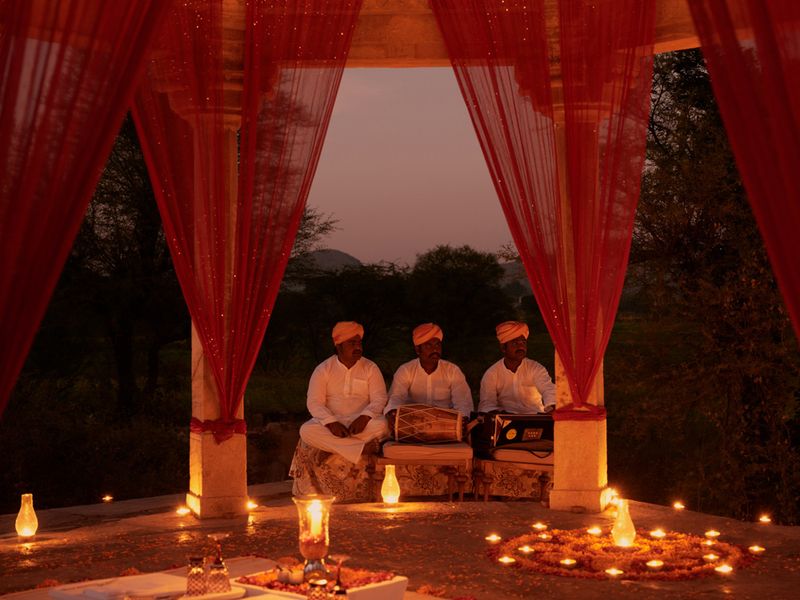
The sights
Bhangarh - a spooky spectacle
There is no dearth of haunted, enigmatic sites in the region. A 30-minute drive from Ajabgarh is Bhangarh, a 17th-century township built by Diwan Madho Singh of the Jaipur royal family and one of the most haunted places in the country. Once bustling with market bazaars, palaces lush gardens and bathing pools, the town of 40,000 inhabitants is said to be deserted overnight.
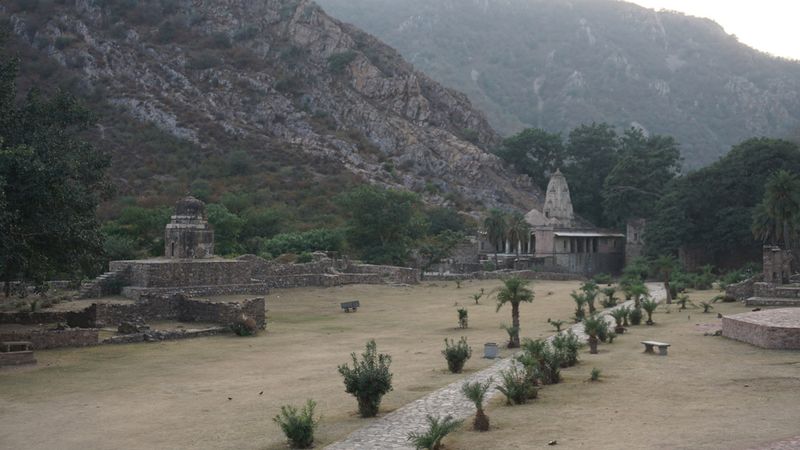
Our guide Balveerji recounted the two legends around it. As per one story, a black magician named tantrik Singhia was smitten by the beauty of Queen Ratnavati. He tried to seduce her in various ways but failed at it every single time. So, he decided to cast a spell on her through a perfume bought from the market by one of her maids. However, Ratnavati found out about his wicked plans and emptied the entire bottle on a huge boulder. This deeply disappointed Singhia who cursed the queen and all others living inside the fort which led to the destruction of the town and its residents. The other folklore speaks of Balu Nath who resided on the hilltop where the fort was built. While the royal family did seek his permission when constructing the fort, they failed to abide by his condition that in no circumstance should the shadow of the fort fall on his dwelling. The sadhu’s curse subsequently led to the devastation of the fort.
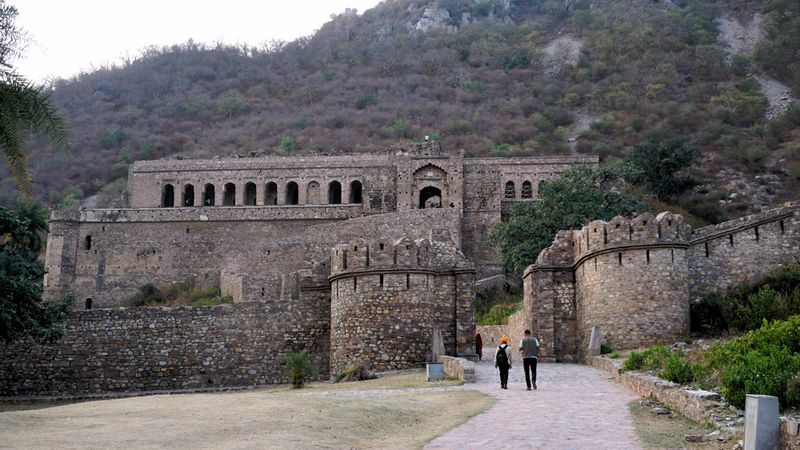
As we rambled through the well-preserved site, Balveerji pointed at the sections where the market bazaars once stood and the chhatri or little domed structure that belonged to the tantrik. Beautified by age-old Banyan and palm trees, the carved temples, bathing pools, gardens and the fort are now in ruins. However, it wasn’t tough for us to imagine life in this town back in the day. Due to the countless stories of ghostly sightings in Bhangarh, visitors are advised to leave before sunset.
Neelkanth - a medieval temple town
The temple town of Neelkanth, known as Rajyapura and Paranagar during medieval times, makes for another fascinating excursion from Ajabgarh. Sitting in a valley dotted with lush fields and bordered by mountains on all sides, the town is filled with scattered ruins and broken parts of more than 100 splendidly carved temples from the 6th century, an old stepwell and some white Rajasthani-style temples built in the memory of martyred ancestors.
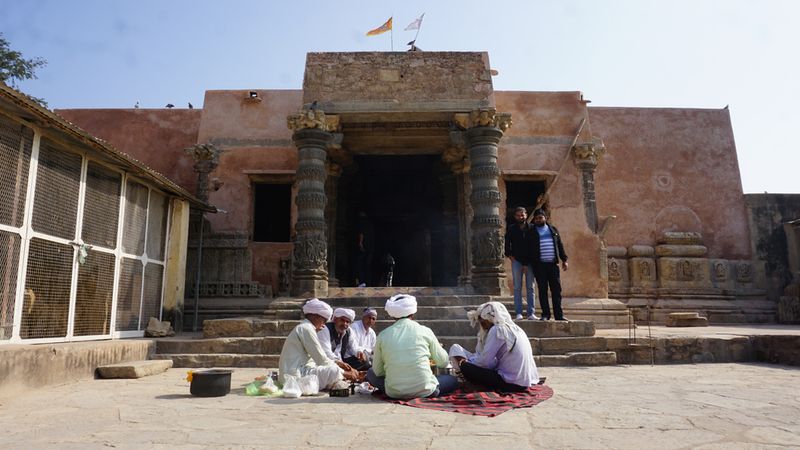
There is a single working temple complex here – the Neelkantheshwar mandir dedicated to Lord Shiva. It is said to have survived the onslaught of Aurangzeb’s army which was forced to leave the site after being attacked by hordes of bees. This is where you can also watch the locals performing their prayers.
After walking a few steps ahead, we arrived at the remains of the Naugaja temple, where a tall sandstone statue of the Jain Tirthankara Shantinatha stands on a high platform. The sublime sculpture which still retains a certain aura is guarded by a rocky structure on both sides, with a few stairs in the forward-facing portion.
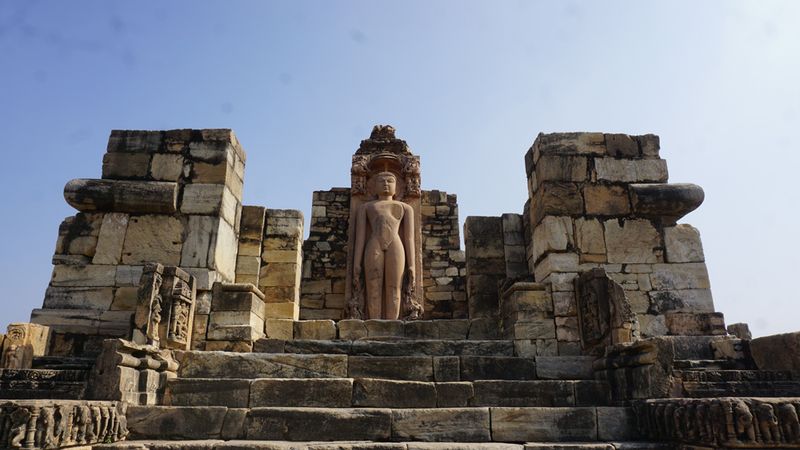
While the ruins of Neelkanth remained neglected for many years, it is only recently that the Archaeological Survey of India (ASI) has started taking due conservation and restoration measures.
Sariska National Park – a tropical tiger reserve
If you’ve had your fill of heritage, architecture and ghost stories, tap into untamed wilderness with a safari or two at the Sariska National Park, once the personal hunting ground of the Maharaja of Alwar and now a reserve for endangered tigers. A 45-minute to an hour’s drive from Ajabgarh, the 881 sq km tropical, dry deciduous forest boasts a unique landscape dominated by dhok, palm, pipal, banyan and neem trees as well as perennial lakes, streams and waterfalls. While the majestic tiger is the prime attraction here, keep an eye out for leopard, desert cat, caracal, fishing cat, jackal, striped hyena, desert fox, palm civet, and crocodile as well as herbivorous animals such as Sambhar deer, the spotted deer, four-horned antelope and nilgai.
Safari at Sariska
For birding enthusiasts, there are almost 300 species of resident and migrated birds found in the Sariska forest. The list includes peafowl, sand grouse, golden-backed woodpeckers, crested serpent eagles, paradise flycatchers, and Indian pitta among others. While we didn’t spot a big cat on our morning safari expedition, it was complete with moments of thrill and anticipation. Savouring nature in the company of a highly knowledgeable guide elevated The Jungle Book experience to a different level altogether.
Consider a day trip to the Pink City
If you haven’t been to Jaipur, this is your chance to discover the delights of the Pink City named after the great warrior king, Maharaja Jai Singh II. As we departed from Amanbagh for Jaipur, our first stop was Panna Meena Ka Kund, located in the northwest part of Amer, on the Jaipur-Amer road near the Anokhi Museum.
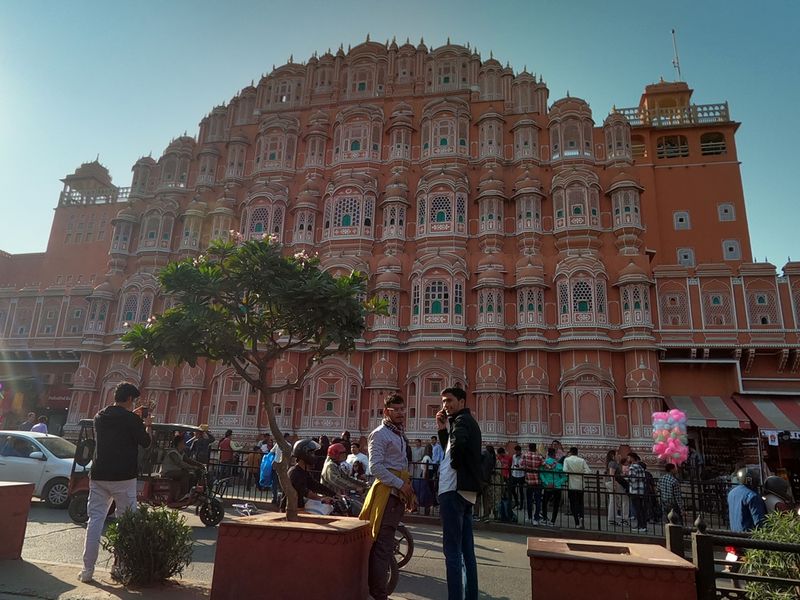
The symmetrical arrangement of stairs in a criss-cross manner is a combination of ingenious Indian engineering and architectural beauty. Next, spend an hour or two at the magnificent Amer Fort, an extensive palace complex that has been built with pale yellow and pink sandstone and white marble. The local guides here double up as photographers and offer their services for a reasonable fee of INR 250 to INR 300. Having a guide take you around the fort gives you a deeper understanding of the artwork, history and architecture of the palace with four main sections featuring the King’s quarters, the zenana (where the women lived), gardens, temples, diwan-e-aam (hall of public audience), the Sheesh Mahal (a palace of glass) etc. The City Palace, Hawa Mahal, Jantar Mantar and the well-planned Old Town with its terracotta pink buildings are other top highlights.
We made sure to sample the local delicacies such as kachori from LMB (Laxmi Mishthan Bhandar) and lassi at Lassiwala, MI Road. Your trip to Jaipur is incomplete unless you have strolled and shopped at some of its iconic bazaars like Johari Bazaar (for jewellery), Tripolia Bazaar (for bangles), Chandpole Bazaar (for handicrafts), Kishanpole Bazaar (for textiles), Nehru Bazaar (for traditional jootis), Bapu Bazaar (for all things Jaipuri) among others. There are ample shops that sell an array of hand-block printed items - from quilts and bed sheets to kurtas, jackets and dresses. While we had no concrete plans for shopping, we returned with a bag full of block-printed souvenirs.
How to reach Amanbagh
Amanbagh in the Ajabgarh Forest Range is a 90-minute road journey from Jaipur which can be easily reached by plane, bus, and train. Major Indian cities including Jodhpur, Udaipur, Delhi, Mumbai, and Ahmadabad offer flights to Jaipur. Alternatively, a five-hour road trip from New Delhi can bring you to Ajabgarh. For reservations, visit https://www.aman.com/resorts/amanbagh.


_1707890130419_thumb_1200.jpeg?w=3840&q=75)
_1707237485249_thumb_300.jpeg)